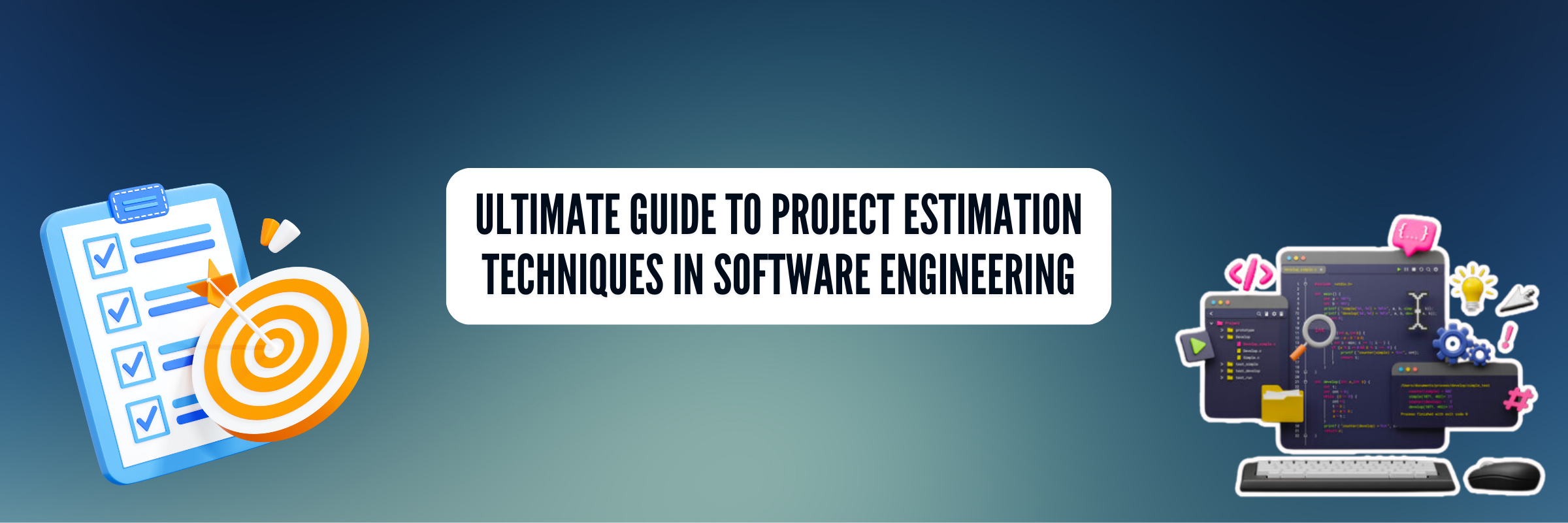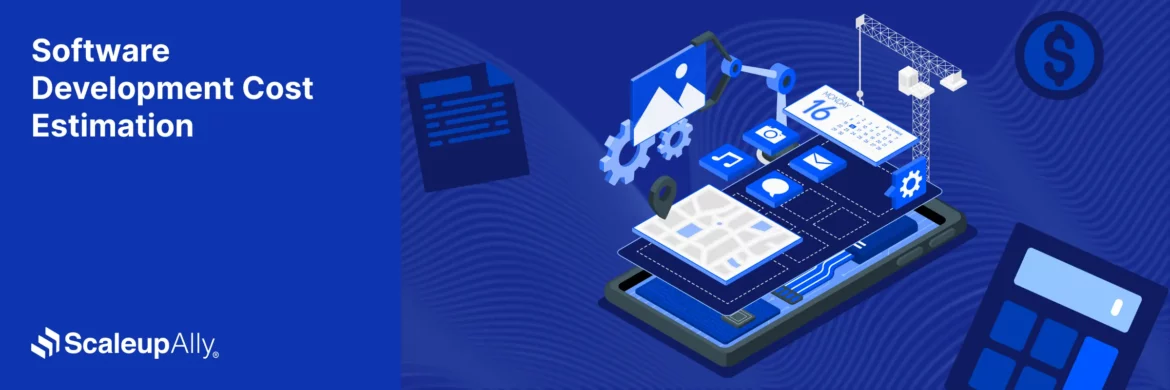
5 Best Project Estimation Techniques in Software Engineering
Suprabhat Sen | June 27, 2024 , 14 min read
Table Of Content
Ever feel like you’re flying blind when it comes to predicting how long a software project will take? You’re not alone. Accurate project estimation is a critical, yet often elusive, aspect of software development. Inaccurate estimates can lead to missed deadlines, budget overruns, and frustrated clients. Conversely, getting the estimation right unlocks several benefits including Improved resource allocation, reduced project risks, and enhanced client satisfaction.
This guide dives deep into a variety of project estimation techniques, each catering to different project stages and complexities. We’ll explore:
- Top-down vs. Bottom-up Estimation: Understanding the big picture versus detailed task breakdown.
- Expert Judgment: Leveraging the wisdom of experienced developers.
- Three-point Estimation: Accounting for optimistic, pessimistic, and most likely scenarios.
- Analogous Estimation: Basing estimates on similar past projects.
- Parametric Estimation: Utilizing historical data to predict effort based on project size and complexity.
- And more!
This guide will equip you to tackle project estimation techniques in software engineering head-on. Let’s get started.
Key Takeaways
- Accurate project estimation ensures realistic timelines, budget control, resource allocation, and risk mitigation, ultimately leading to better project outcomes and client satisfaction.
- Some of the popular estimation techniques include: top-down and bottom-up methods, expert judgment, three-point estimation, analogous estimation, and parametric estimation.
- Choosing the right estimation technique depends on factors such as the project stage, complexity, availability of historical data, and the expertise of the team.
- Combining techniques, such as starting with top-down for an initial overview and refining with bottom-up for granular accuracy, can enhance estimation reliability.
Understanding Software Project Estimation
Before diving into specific project estimation techniques used in software engineering, let’s solidify our foundation with some key terms:
- Effort: This refers to the total amount of work required to complete a project, typically measured in person-hours.
- Time: The estimated duration for completing a project, often expressed in weeks or months.
- Cost Estimation: Translating effort and time into a projected financial cost for the entire project. This can include developer salaries, infrastructure, and other expenses.
- Project Scope: The clearly defined boundaries of what the project will deliver. It outlines the features, functionalities, and limitations of the software.
Also Read: How To Calculate ROI For Software Development
The Software Development Lifecycle (SDLC)
The SDLC is a structured framework that guides the software development process, typically involving phases like planning, design, development, testing, deployment, and maintenance. Estimation plays a crucial role throughout the SDLC:
- Planning: Initial estimates are made based on high-level project requirements.
- Design & Development: As the project progresses, estimates are refined through task breakdown and technical analysis.
- Testing & Deployment: Estimations are used to predict testing and deployment timelines.
How Estimation Fits in SDLC?
Estimation is a critical component throughout the SDLC. During the planning phase, effort, time, and cost estimation help in creating a realistic project plan. Accurate estimation ensures that the project has the necessary resources and time allocated to meet its goals.
Throughout the development and testing phases, re-estimations may be needed as new information becomes available, helping to keep the project on track. Effective estimation is essential for successful project management, ensuring that projects are completed on time, within budget, and to the desired quality standards.
What is the software project estimation technique?
A software project estimation technique is a method used to predict the effort, time, and cost required to complete a software development project. These techniques provide a framework for translating project requirements into a realistic roadmap.
There are several different project estimation techniques in software engineering, each with its strengths and weaknesses. The best technique for a particular project will depend on factors like the project’s size, complexity, and the availability of historical data.
5 Popular Project Estimation Techniques
Software development thrives on accurate planning, and at the heart of that planning lies effective effort estimation. Here’s a breakdown of some popular effort estimation techniques in software engineering to equip you for this crucial task:
1. Top-Down vs. Bottom-Up Estimation
- Top-down: This approach takes a high-level view of the project, considering overall functionality. The project scope is broken down into major features, and estimates are made for each. These estimates are then summed to get a total project estimate. Think of it as starting from the big picture and zooming in.
- Bottom-up: This approach flips the script. Here, the project is divided into its smallest, most granular tasks. Each task is then individually estimated for effort and time. These individual estimates are then added up to arrive at the total project estimate. It’s like building the estimate brick by brick.
2. Expert Judgment
This technique leverages the experience and knowledge of seasoned developers or project managers. Experts provide estimates based on their understanding of the project scope, similar projects they’ve worked on, and potential technical hurdles. It’s like having a wise advisor assess the project landscape.
3. Three-point Estimation
This statistical approach acknowledges the inherent uncertainty in project estimation. Here, experts provide three estimates for each task:
- Optimistic: The best-case scenario, assuming everything goes perfectly.
- Pessimistic: The worst-case scenario, considering all potential roadblocks.
- Most Likely: The most realistic estimate based on experience and project complexity.
A statistical formula is then used to calculate a weighted average, providing a more robust and realistic overall project estimate. Think of it as triangulating the most likely outcome.
4. Analogous Estimation
This technique leverages the power of history. If you have data from similar projects completed in the past, you can use that information to estimate the effort and time required for the current project. This is particularly useful for projects with similar features or functionalities. It’s like learning from past experiences to predict the future.
5. Parametric Estimation
This method goes beyond simple analogies. It utilizes statistical models and historical data to create a more sophisticated estimation formula. Project parameters like size and complexity are fed into the model, along with historical data points, to predict project costs. Think of it as using historical trends to build a predictive model.
These are just some of the popular project estimation techniques. By understanding their strengths and weaknesses, you can choose the right tool for the job and make informed decisions about your software development roadmap.
Choosing the Right Estimation Technique
Project estimation isn’t a one-size-fits-all game, especially when considering project estimation techniques in software engineering. The ideal technique depends on the unique characteristics of your software development project.
Here’s a framework that will guide your selection:
1. Project Stage
- Early Stage (Limited Information): When project requirements are still evolving, techniques like Expert Judgment or Top-down Estimation with broad strokes can provide a starting point.
- Mid Stage (Refined Requirements): As the project scope becomes clearer, techniques like Three-point Estimation or Analogous Estimation (if similar projects exist) can offer more precise estimates.
- Later Stage (Detailed Breakdown): With a well-defined scope, Bottom-up Estimation shines. It allows for a granular breakdown of tasks and more accurate effort and time estimates.
2. Project Complexity
- Simple Projects: For less complex projects, Expert Judgment or Top-down Estimation might be sufficient.
- Complex Projects: For intricate projects with numerous dependencies, Bottom-up Estimation or Parametric Estimation (if historical data is available) provides greater accuracy.
3. Availability of Historical Data
- Limited Data: If historical data on similar projects is scarce, techniques like Expert Judgment or Three-point Estimation would be more suitable.
- Rich Data: When you have access to historical data on similar projects or industry benchmarks, techniques like Analogous Estimation or Parametric Estimation can be highly effective.
4. Project Team Expertise
- New Team: For teams with limited experience on similar projects, Top-down Estimation or Expert Judgment from external consultants can be valuable.
- Experienced Team: If your team has a strong understanding of the project domain, Bottom-up Estimation or Three-point Estimation can leverage their expertise.
Bonus Tip: Consider Combining Techniques!
Don’t be afraid to combine techniques. For instance, you can use Top-down Estimation for a high-level overview and then refine it with Bottom-up Estimation for specific tasks.
By following this framework and considering the specific context of your project, you can make an informed decision about the best estimation technique(s) to use.
This will pave the way for realistic project timelines, resource allocation, and ultimately, successful software development.
Best Practices for Accurate Software Project Estimation
Even with the right technique, achieving accurate software project estimation in engineering requires a strategic approach. Here are some best practices for software project estimation:
1. Invest in Requirements Gathering
A shaky foundation leads to a shaky estimate. Spend ample time gathering and documenting clear, concise, and measurable requirements. This includes user stories, functional specifications, and non-functional requirements (security, performance). The more precise the requirements, the more accurate your estimates will be.
2. Break Down the Project into Manageable Chunks
Large, monolithic projects are estimation nightmares. Divide the project into smaller, well-defined tasks (user stories, features) that can be individually estimated. This granular breakdown allows for a more precise understanding of the effort involved.
3. Involve the Right People
Estimation is a collaborative effort. Include developers, designers, testers, and other stakeholders in the estimation process. Their diverse perspectives can help identify potential challenges and ensure estimates are grounded in reality.
Also Read: How To Choose Perfect Software Development Partner?
4. Embrace Historical Data (if available)
Past projects are goldmines of information. If you have historical data on similar projects, leverage it! Use techniques like analogous estimation or parametric estimation to get a data-driven baseline for your current project.
5. Don’t Fear the “Cone of Uncertainty”
Project estimation is not an exact science. There will always be a degree of uncertainty. Techniques like three-point estimation acknowledge this by considering optimistic, pessimistic, and most likely scenarios. Communicate this uncertainty to stakeholders and set realistic expectations.
6. Use Estimation Tools (but rely on Expertise too)
There are various estimation tools available online. These tools can be helpful for tasks like time tracking and effort allocation. However, remember, estimation tools are not magic bullets. Use them to complement your team’s expertise and judgment, not replace it.
7. Refine Estimates as the Project Progresses
As the project unfolds, your understanding of the scope and complexity may evolve. Be prepared to revisit and refine your estimates throughout the development lifecycle. This ensures your project stays on track and avoids unpleasant surprises.
8. Foster a Culture of Transparency and Communication
Open communication is paramount. Discuss estimation assumptions with stakeholders, explain the rationale behind your techniques, and be transparent about potential risks and uncertainties. This builds trust and fosters a collaborative environment where everyone is invested in project success.
Common Mistakes in Software Project Estimation
Even the most experienced software professionals can fall prey to estimation pitfalls. Here are some common mistakes to watch out for:
1. Underestimating Scope Creep
Project requirements are rarely static. Be prepared for scope creep, where new features or functionalities are added mid-project. This can significantly inflate effort and timelines. Build in buffer time or use techniques like agile development that allow for flexible scope adjustments.
2. Ignoring Risks and Dependencies
Unforeseen technical hurdles, resource availability issues, or external dependencies can derail even the most meticulously planned project. Identify potential risks early on and factor them into your estimates. Proactive risk mitigation strategies can help minimize their impact.
3. Overly Optimistic Estimates
Sometimes, the desire to please clients or meet unrealistic deadlines can lead to rosy-hued estimates that are far from reality. Stick to objective data and be transparent about potential challenges to avoid setting unrealistic expectations.
4. Neglecting Non-Technical Effort
Coding isn’t everything. Factor in time for activities like design, testing, documentation, communication, and meetings. These non-technical tasks can consume a significant amount of effort, and neglecting them in estimates can lead to shortfalls.
5. Failing to Account for Team Velocity
Different teams have different working paces. When estimating, consider your team’s historical velocity (rate of delivering work) to create realistic timelines. Don’t base estimates on an ideal scenario; use real-world data to set achievable goals.
6. Inaccurate Task Breakdown
Large, ill-defined tasks are difficult to estimate accurately. Break down project work into smaller, clearly defined tasks that can be individually estimated with greater precision.
7. Not Involving the Right People
Estimation shouldn’t be a one-person show. Include developers, testers, and other stakeholders in the process. Their expertise can help identify potential roadblocks and ensure estimates are practical.
8. Ignoring Communication
Estimation is an iterative process. Communicate assumptions, uncertainties, and potential risks to stakeholders throughout the project lifecycle. This fosters transparency, builds trust, and allows for adjustments as needed.
Conclusion
This guide has equipped you with the knowledge on estimating software projects. Here are the key takeaways to remember:
- Estimation is Crucial: Accurate estimates set the stage for realistic project timelines, resource allocation, and ultimately, successful software development.
- Choose the Right Technique: Different techniques like top-down, bottom-up, or three-point estimation are suited for various project stages and complexities.
- Best Practices Matter: Invest in clear requirements, involve the right people, leverage historical data if available, and foster open communication.
- Avoid Common Pitfalls: Beware of scope creep, overly optimistic estimates, and neglecting non-technical tasks.
Estimation is an ongoing process that requires continuous learning and adaptation. By staying updated on new techniques, learning from case studies, and reflecting on your own experiences, you can refine your estimation skills and lead your software projects to predictable success.
So, embrace the journey, hone your estimation craft, and watch your projects soar!
Are you ready to elevate your project estimation and development process? Discover how ScaleupAlly’s custom software development services can bring your vision to life with precision and efficiency.
Read our case studies to see how we’ve helped clients achieve outstanding results. Partner with ScaleupAlly today and experience the difference.
Frequently Asked Questions (FAQs)
Q: How accurate can software project estimates really be?
Software project estimates can vary in accuracy, often influenced by the project’s complexity and the experience of the estimators. Regular reviews and adjustments can help improve accuracy over time.
Q: Can I use estimation techniques in both Agile and Waterfall methodologies?
Yes, estimation techniques can be applied in both Agile and Waterfall methodologies, though the approaches may differ. Agile focuses on iterative estimates, while Waterfall relies on detailed upfront estimates.
Q: What are some project management tools that can help with estimation?
Project management tools like JIRA, Trello, Microsoft Project, and Asana can assist with estimation by offering features for task tracking, resource allocation, and progress monitoring.
Q: What happens if my initial estimates are off target?
If initial estimates are off target, it’s important to reassess and adjust them as the project progresses. Regular reviews and flexibility in planning can help manage and mitigate any discrepancies.
Related Blogs

Top 20 Emerging Technologies of 2026
Discover the top 20 emerging technologies of 2026. Explore which innovations are driving change across healthcare, finance, manufacturing, and other crucial industries.
ScaleupAlly Team
Dec 16 ,
9 min read

Software Development Timeline: Phases, Duration & Estimation Guide
Understand the software development timeline with phase durations, key factors, hidden delays, and practical methods to estimate project time.
Suprabhat Sen
Nov 29 ,
16 min read

Software Development Cost Estimation Guide: What’s Included & What Affects the Price
Explore software development cost components, major pricing factors, and practical estimation methods to plan your project accurately from start to finish.
Suprabhat Sen
Nov 29 ,
14 min read



